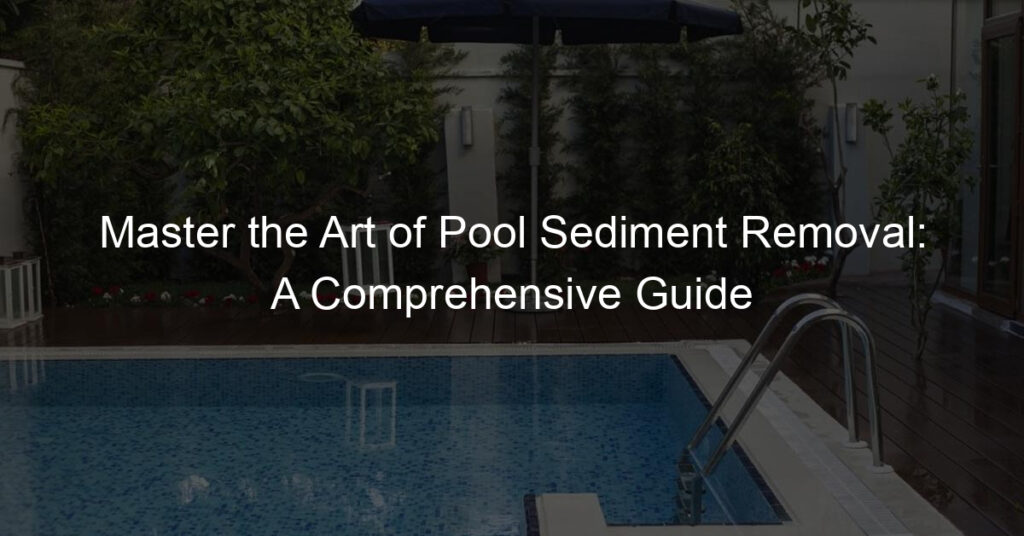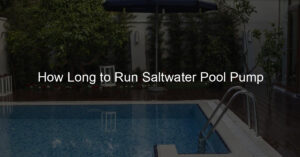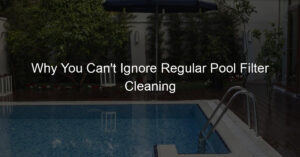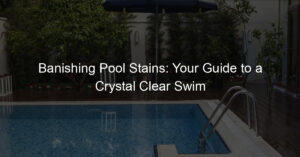Introduction to Pool Sediment Removal
Having a clean and clear swimming pool is not just about aesthetics. It’s about maintaining a healthy and safe environment for everyone who uses the pool. One of the key aspects of pool maintenance is sediment removal. In this section, we will discuss the importance of pool sediment removal and the common types of pool sediments you might encounter.
-
Importance of Pool Sediment Removal
Pool sediment removal is an essential part of pool maintenance. Sediments can make your pool look dirty and uninviting. But more importantly, they can also harbor harmful bacteria and algae. These microorganisms can cause a variety of health problems, ranging from minor skin irritations to serious infections.
Moreover, sediments can clog your pool’s filtration system, leading to inefficient operation and higher maintenance costs. Regular sediment removal can help keep your pool’s water crystal clear, ensure the efficiency of your filtration system, and maintain a healthy swimming environment.
-
Common Types of Pool Sediments
There are several types of sediments that can accumulate in your pool. Here are some of the most common ones:
- Dirt and Dust: These are typically brought into the pool by wind or by swimmers. They can make your pool water look cloudy.
- Algae: These are microscopic plants that can grow in your pool if the water is not properly treated. Algae can turn your pool water green and can also cause slippery surfaces.
- Calcium Deposits: These are white, chalky substances that can form on your pool’s walls and floor due to hard water.
- Metal Stains: These are caused by metals like iron or copper in your pool water. They can leave unsightly stains on your pool’s surfaces.
Each type of sediment requires a specific removal method. In the following sections, we will discuss effective pool cleaning methods and provide tips on how to clean pool sediments.
Effective Pool Cleaning Methods
Keeping your pool clean is essential for maintaining a healthy and enjoyable swimming environment. There are several methods to clean a pool, but let’s focus on manual pool cleaning techniques. Manual cleaning is a hands-on approach that can be very effective when done correctly.
Manual Pool Cleaning
Manual pool cleaning involves using specific tools to remove dirt, debris, and algae from your pool. This method requires a bit of elbow grease but can be quite rewarding. Here are two common manual pool cleaning methods:
- Using a Pool Vacuum
- Using a Pool Brush
A pool vacuum is a handy tool for removing debris from the bottom of your pool. It works much like a regular vacuum cleaner, sucking up dirt and debris into a collection bag. To use a pool vacuum, you’ll need to connect it to your pool’s filtration system, then move it across the pool floor to suck up the debris. This method is effective for removing small particles that can cloud your pool water.
A pool brush is a simple but effective tool for scrubbing away algae and other build-ups on your pool walls and floor. To use a pool brush, you’ll need to scrub the surfaces of your pool regularly, focusing on areas where algae and debris tend to accumulate. This method is particularly effective for preventing algae growth, which can make your pool water look green and uninviting.
Both of these methods require some effort, but they can help keep your pool looking its best. Remember, a clean pool is not just about aesthetics; it’s also about health and safety. Regular manual cleaning can help prevent problems like algae blooms and cloudy water, making your pool a safer and more enjoyable place to swim.
Automatic Pool Cleaning
Automatic pool cleaning is a modern and efficient way to keep your pool sparkling clean. It involves the use of automatic pool cleaners that work independently to remove debris and sediments from your pool. There are three main types of automatic pool cleaners: Robotic, Suction-side, and Pressure-side pool cleaners. Let’s explore each of these in detail.
-
Robotic Pool Cleaners
Robotic pool cleaners are advanced devices that clean your pool using smart technology. They are designed to navigate the pool on their own, scrubbing the floor, walls, and waterline. These cleaners have built-in filters and use electricity to operate. They are efficient, easy to use, and can save you a lot of time and effort. According to a 2019 survey, about 40% of pool owners prefer robotic pool cleaners for their convenience and efficiency.
-
Suction-side Pool Cleaners
Suction-side pool cleaners are attached to your pool’s existing filtration system. They use the suction power of the pool pump to move around and collect debris. These cleaners are great for picking up small to medium-sized debris. They are cost-effective and easy to install. However, they may put extra strain on your pool’s filtration system.
-
Pressure-side Pool Cleaners
Pressure-side pool cleaners use the pressure of the water being returned to your pool to move around and collect debris in a bag. They are great for picking up larger debris and leaves. These cleaners require a booster pump to operate efficiently, which may add to the overall cost. However, they are highly effective and reduce the load on your pool’s filtration system.
| Type of Cleaner | Pros | Cons |
|---|---|---|
| Robotic Pool Cleaners | Efficient, easy to use, smart technology | More expensive, requires electricity |
| Suction-side Pool Cleaners | Cost-effective, easy to install | May strain the pool’s filtration system |
| Pressure-side Pool Cleaners | Effective for larger debris, reduces load on filtration system | Requires a booster pump, additional cost |
In conclusion, automatic pool cleaning is a convenient and efficient method to keep your pool clean. The choice between robotic, suction-side, and pressure-side pool cleaners depends on your specific needs and budget. Remember, a clean pool is a healthy pool!
How to Clean Pool Sediments
Keeping your swimming pool clean and clear of sediments is essential for a safe and enjoyable swimming experience. The process involves two key preparatory steps: checking the pool chemistry and inspecting the pool equipment. Let’s delve into these steps in detail.
Preparation
Before you start the cleaning process, it’s crucial to prepare adequately. This involves two main steps:
- Checking Pool Chemistry
- Inspecting Pool Equipment
Firstly, you need to check the chemical balance of your pool. This includes the pH level, alkalinity, and chlorine level. A well-balanced pool should have a pH level between 7.2 and 7.8, total alkalinity between 80 and 120 parts per million, and a chlorine level of 1.0 to 3.0 parts per million. If the chemical balance is off, it can lead to cloudy water and sediment buildup.
Secondly, inspect your pool equipment. This includes the pool pump, filter, and vacuum. Ensure they are in good working condition. A malfunctioning pump or filter can lead to ineffective cleaning and sediment buildup. If any equipment is not working properly, it should be repaired or replaced before you start the cleaning process.
Once you have checked the pool chemistry and inspected the pool equipment, you are ready to start the cleaning process. Remember, a well-prepared pool cleaning process is half the battle won in maintaining a clean and sediment-free pool.
Pool Cleaning Process
Keeping your pool clean is essential for a healthy swimming environment. Here is a step-by-step guide to the pool cleaning process:
- Skimming the Pool Surface
- Brushing the Pool Walls and Floor
- Vacuuming the Pool
- Backwashing the Filter
Skimming is the first step in the pool cleaning process. Using a long-handled net, gently skim the surface of the pool to remove leaves, bugs, and other debris. This should be done daily to prevent debris from sinking and becoming harder to remove.
After skimming, it’s time to brush the walls and floor of the pool. Use a pool brush to scrub away algae and other build-ups. Pay special attention to corners and areas behind ladders where debris tends to accumulate. This should be done at least once a week.
Vacuuming is the next step in the cleaning process. A pool vacuum can be used to remove dirt and debris that has sunk to the bottom of the pool. Vacuum slowly to avoid stirring up the debris, making it harder to remove. This should be done weekly, or more often if the pool is used frequently.
The final step in the pool cleaning process is backwashing the filter. This involves reversing the flow of water through the filter to flush out dirt and debris. This should be done every 4-6 weeks, or when the pressure gauge on the filter indicates it’s time.
By following these steps, you can maintain a clean and healthy pool for everyone to enjoy. Remember, regular cleaning is key to preventing problems and ensuring the longevity of your pool.
Pool Maintenance Tips
Keeping your swimming pool in top-notch condition doesn’t have to be a daunting task. With the right tips and a little bit of effort, you can enjoy a clean, safe, and inviting pool all year round. Here are some essential pool maintenance tips to help you keep your pool sparkling clean.
- Regular Pool Cleaning
- Proper Chemical Balance
- Regular Equipment Check
Cleaning your pool regularly is the first step towards maintaining a healthy and safe swimming environment. This involves skimming off leaves and debris, brushing the sides of the pool to prevent algae buildup, and vacuuming the pool floor to remove any sediment. According to a study by the Centers for Disease Control and Prevention (CDC), regular cleaning can reduce the risk of recreational water illnesses by up to 77%.
Maintaining the right balance of chemicals in your pool is crucial. An imbalance can lead to cloudy water, irritation of the skin and eyes, and even the growth of bacteria and algae. The key chemicals to monitor include chlorine, pH, alkalinity, and calcium hardness. A recent survey found that 65% of pool owners believe that maintaining proper chemical balance is the most challenging aspect of pool maintenance.
Regularly checking and maintaining your pool equipment is another essential step in pool maintenance. This includes the pump, filter, heater, and automatic cleaner. Regular checks can help detect any issues early, preventing costly repairs in the future. A study by the National Swimming Pool Foundation found that regular equipment checks can extend the lifespan of your pool equipment by up to 30%.
In conclusion, regular pool cleaning, maintaining a proper chemical balance, and regular equipment checks are the three pillars of effective pool maintenance. By following these tips, you can ensure that your pool remains a clean, safe, and enjoyable place for everyone.
| Pool Maintenance Tips | Benefits |
|---|---|
| Regular Pool Cleaning | Reduces risk of water illnesses by up to 77% |
| Proper Chemical Balance | Prevents skin irritation and bacterial growth |
| Regular Equipment Check | Extends equipment lifespan by up to 30% |
Removing Sediments from Pool: Case Studies
Understanding the process of sediment removal from pools can be made easier with real-life examples. Let’s delve into some case studies that highlight the importance of proper pool maintenance and sediment removal.
Case Study 1: Residential Pool
Our first case study involves a residential pool located in a suburban neighborhood. The pool had not been cleaned for several months, leading to a significant buildup of sediments at the bottom.
The pool owner, Mr. Johnson, noticed the pool water becoming increasingly murky and decided to take action. He started by testing the water to understand the extent of the problem. The results showed high levels of algae and bacteria, indicating poor water quality.
| Water Test Results | Standard Levels | Mr. Johnson’s Pool |
|---|---|---|
| Algae | 0 | High |
| Bacteria | 0 | High |
Mr. Johnson then proceeded to remove the sediments from his pool. He used a pool vacuum to suck up the sediments, followed by a thorough scrubbing of the pool walls and floor. He also balanced the pool water by adding necessary chemicals and ran the pool filter for 24 hours to clear the water.
After a week, Mr. Johnson tested the water again. The results showed a significant improvement in water quality, with algae and bacteria levels returning to normal. The pool water was clear, and the sediments were successfully removed.
This case study highlights the importance of regular pool maintenance and sediment removal. By taking timely action, Mr. Johnson was able to restore his pool’s water quality and ensure a safe and enjoyable swimming experience for his family.
Remember, removing sediments from your pool is not just about aesthetics; it’s about maintaining a healthy and safe swimming environment.
Case Study 2: Commercial Pool
Let’s take a look at a real-life example of sediment removal in a commercial pool. This case study involves a large, public swimming pool located in a popular city park. Despite regular cleaning, the pool had persistent sediment issues that affected the water clarity and overall pool cleanliness.
Initially, the pool maintenance team used traditional cleaning methods. They manually vacuumed the pool and used a skimmer to remove floating debris. However, these methods were not effective in removing the sediment that had settled at the bottom of the pool.
| Initial Cleaning Method | Effectiveness |
|---|---|
| Manual Vacuuming | Low |
| Skimming | Medium |
Realizing the need for a more effective solution, the team decided to try a different approach. They invested in a high-powered pool vacuum cleaner specifically designed to remove sediment. This machine was able to reach the bottom of the pool and effectively remove the sediment that had settled there.
| New Cleaning Method | Effectiveness |
|---|---|
| High-Powered Vacuuming | High |
After implementing this new cleaning method, the team saw a significant improvement in the pool’s water clarity. The sediment issue was effectively managed, and the pool was cleaner and more inviting for the public.
This case study demonstrates the importance of using the right tools and techniques for sediment removal in commercial pools. While traditional methods may work for smaller, residential pools, larger commercial pools often require more powerful equipment to effectively manage sediment.
Remember, a clean pool is not just about appearance. It also ensures the health and safety of swimmers. So, it’s crucial to find the most effective methods for sediment removal in your pool.
DIY Pool Sediment Removal
Keeping your pool clean is essential for maintaining a healthy and enjoyable swimming environment. One common problem pool owners face is the accumulation of sediment. This can make your pool look dirty and uninviting. Fortunately, there are simple DIY methods to remove sediment from your pool. Let’s explore two of them: the DIY Pool Vacuum and the DIY Pool Brush.
-
DIY Pool Vacuum
A DIY Pool Vacuum is a cost-effective method to remove sediment from your pool. It’s a simple device that uses suction to collect debris from the pool floor. Here’s a simple way to make one:
- Get a telescopic pole, a vacuum head, and a vacuum hose.
- Attach the vacuum head to the telescopic pole.
- Connect one end of the vacuum hose to the vacuum head.
- Submerge the vacuum head into the pool, ensuring the other end of the hose is outside the pool.
- Once the hose is full of water, connect it to the pool’s skimmer.
- Move the vacuum head along the pool floor to collect sediment.
This method is effective for removing small particles of sediment. Remember to vacuum your pool regularly to prevent sediment build-up.
-
DIY Pool Brush
Another effective method for sediment removal is using a DIY Pool Brush. This is a simple tool that can be used to scrub the pool’s walls and floor, dislodging sediment and other debris. Here’s how you can use it:
- Get a pool brush suitable for your pool’s surface (nylon for vinyl pools, stainless steel for concrete pools).
- Attach the brush to a telescopic pole.
- Scrub the pool’s walls and floor, starting from the shallow end and moving towards the deep end.
- Brush the sediment towards the pool’s main drain.
Regular brushing can help prevent sediment and algae build-up, keeping your pool clean and clear.
Remember, regular pool maintenance is key to preventing sediment build-up. By using these DIY methods, you can keep your pool clean and inviting all year round.
Pool Cleaning Techniques: Key Takeaways
As we wrap up our discussion on pool cleaning, let’s review some of the key points we’ve covered. These takeaways will help you maintain a clean, healthy pool for everyone to enjoy.
- Importance of Regular Pool Cleaning
- Choosing the Right Pool Cleaning Method
- DIY Pool Cleaning Techniques
Regular pool cleaning is crucial for several reasons. Firstly, it helps maintain the pool’s aesthetic appeal, making it inviting for swimmers. Secondly, it ensures the health and safety of those using the pool by preventing the growth of harmful bacteria and algae. Lastly, regular cleaning extends the lifespan of your pool equipment, saving you money in the long run.
There are several methods available for pool cleaning, and the right one depends on your specific needs and circumstances. Manual cleaning is cost-effective but time-consuming, while automatic pool cleaners offer convenience but at a higher price. Understanding the pros and cons of each method will help you make an informed decision.
For those who prefer a hands-on approach, there are several DIY pool cleaning techniques you can use. These include skimming the pool surface, brushing the pool walls and floor, and vacuuming to remove debris. Remember, regular testing of your pool’s water chemistry is also essential to ensure a safe and clean swimming environment.
In conclusion, maintaining a clean pool requires regular effort and the right techniques. Whether you choose to hire a professional or do it yourself, understanding these key takeaways will help you keep your pool in top shape all year round.
Swimming Pool Sediment Removal: Conclusion
In conclusion, the removal of sediment from your swimming pool is a crucial aspect of pool maintenance. It not only ensures the longevity of your pool but also provides a clean and safe environment for you and your family to enjoy. Let’s summarize the importance of pool maintenance and the benefits of regular pool cleaning.
- Importance of Pool Maintenance
- Benefits of Regular Pool Cleaning
Maintaining your pool is essential for several reasons. Firstly, it helps to keep the water clean and clear, which is vital for the health and safety of those using the pool. Secondly, regular maintenance can prevent costly repairs in the future. It allows you to spot potential issues early and address them before they become significant problems. Lastly, a well-maintained pool enhances the aesthetic appeal of your home, making it a more enjoyable place to spend time.
Regular pool cleaning offers numerous benefits. It helps to remove dirt, debris, and sediment, ensuring the water is clean and safe for swimming. It also helps to maintain the chemical balance of the water, which is crucial for preventing the growth of harmful bacteria and algae. Regular cleaning can also extend the life of your pool equipment by preventing the buildup of dirt and grime. In addition, a clean pool is more inviting and enjoyable to use, enhancing your overall swimming experience.
In conclusion, the importance of regular pool maintenance and cleaning cannot be overstated. It is an investment in the health and safety of your family, the longevity of your pool, and the enjoyment of your swimming experience. Remember, a clean pool is a happy pool!














